Imagine this – your child has just drawn a picture and rushes to you and says, “Look, look, look!” You might respond with something like:
“It’s so pretty!”
“I love it!”
“You’re really good at drawing!”
“I’m so proud of you!”
“Wow, good job!”
While well-intentioned, these are all phrases that we want to AVOID when talking kids art.
What?! Why? Those all sound like really nice things to say to help build kids’ self-esteem.
In reality, each of those statements passes a value judgment. The focus is on the product being “good.” Kids learn that what they make is more important than the process of making it.
The final product is valued over all the hard work that kids put in or the enjoyment that they experienced while creating. This creates a fixed mindset instead of a growth mindset. Kids are taught to do the things they are “good” at because that is what they are rewarded for.
In addition, the above statements are all examples of praise, which can actually be bad for kids. They teach kids that outside options matter more than their own opinions or experiences. Kids give up some control of their happiness by allowing others to decide if they’re good enough. This creates a need for external validation.
Finally, you’re probably lying. Your 2-year-old didn’t create a masterpiece.
They did express themself, build their fine motor skills, learn what happens when they mix all the colors, develop their focus, learn more about their interests, and have some fun. These are all great things that we should value much more than how their picture turned out.
How to Talk About Kids Art
This may all seem nitpicky, but your words are powerful! Making a few slight shifts can have a significant impact on your kids. It’s the difference between a child who is happy and content with their efforts and one who needs validation from others.
So what should you say instead?
Here are some ways to talk about your child’s projects that will encourage them to articulate their feelings and ideas about the things that they have made. Feel free to use multiple ways to talk about the same project.
Simply describe what you see.
“I notice that you used some red and some blue paint.”
“I see some straight lines and some squiggly lines.”
“I see a square on the top and a circle on the bottom.”
By describing what you see, you’re introducing kids to new words. That’s some great language and literacy development right there! Your specific observations also show that you’re taking the time to look at what they have made and demonstrate how much you care.
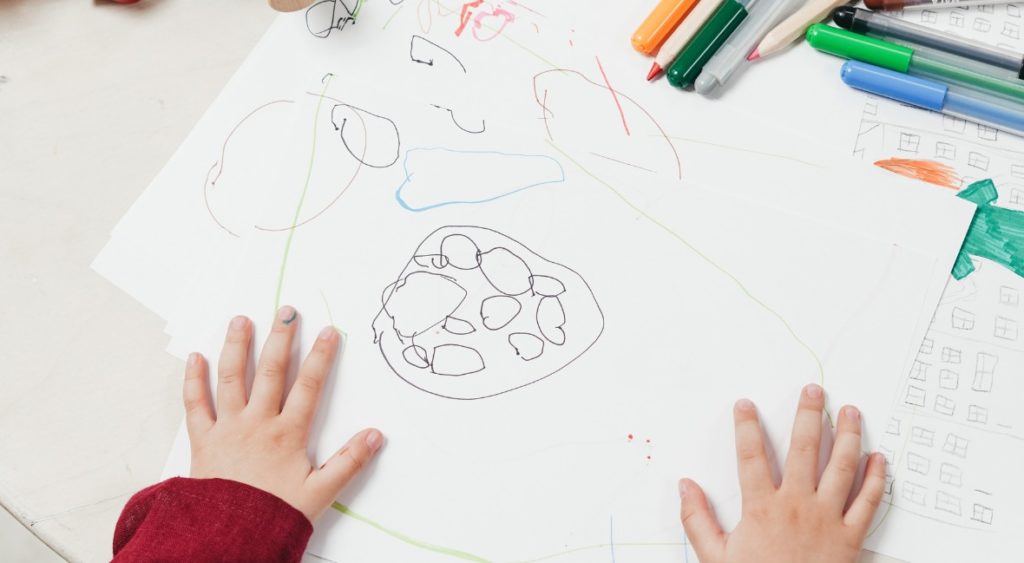
Ask to learn more about it.
“Tell me about it.”
Notice how we avoid asking, “What is it?” or trying to guess what something might be. First, it might not be anything at all. Kids may just be expressing themselves creatively and not drawing a princess or a dog. Second, we often guess wrong when we try to guess what something might be, which shuts kids down.
Instead, ask an open-ended question like, “Tell me about it,” and sit back and let kids share away. Taking the time to listen demonstrates how much we care and shows our kids we value their creations.
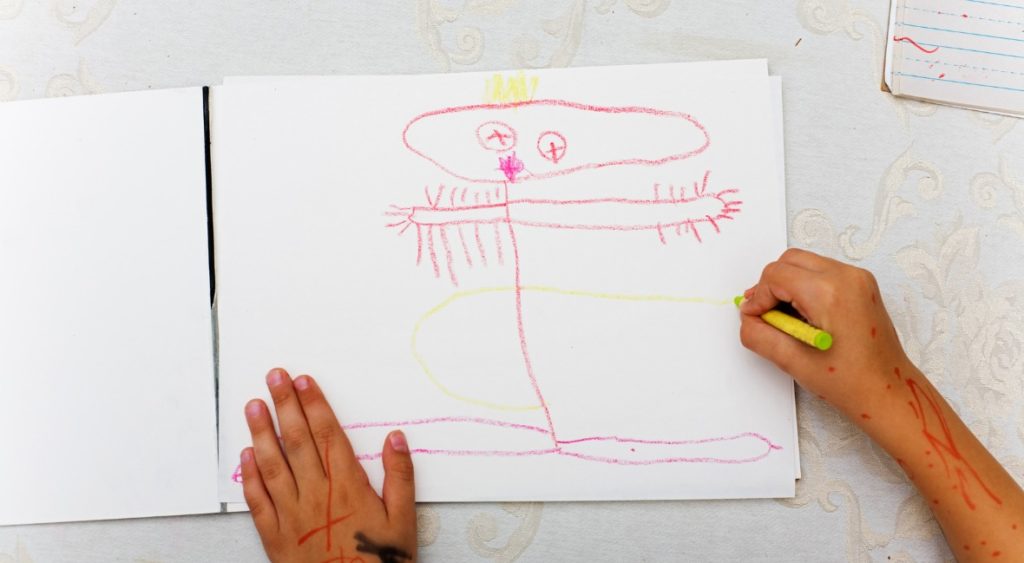
Describe what you noticed about the process.
“It looks like you really enjoyed squeezing the glue.”
“It looks like you had a lot of fun doing that project!”
“I noticed how hard you worked on the painting.”
“It looks like you had a lot of fun with the hole punch today!”
“It looked like you got pretty frustrated when the tissue paper didn’t stick how you wanted! What did you do to figure it out?”
This shows kids that the whole process is important and that lots of great learning happens along the way. This is how we build a growth mindset.
FAQs
1. What should I say when my child asks, “Do you like it? Is it pretty?”
You can turn the question back around and ask, “Well, what do you think about it? Do you like it?” This will allow you to have a conversation and help your child think through their thoughts and feelings.
Maybe they will tell you that they don’t like it, and that’s okay too. You don’t have to jump in and defend what they made. That wouldn’t be very validating. You can stay neutral and ask, “Oh, why is that?”
2. How should I respond when a child’s feelings are hurt after another child says something negative about their artwork?
Maybe a child rushes over to you crying and says, “Tom said my painting is ugly, and he doesn’t like it!”
You want to avoid telling them how much you LOVE it or being dismissive. Instead, the first thing you can do is acknowledge the child’s feelings. “It looks like it made you sad and mad when Tom said that he didn’t like your painting.” We always want to validate kids’ feelings and help them to name their emotions.
Next, you can ask the same thing as above: “Well, what do you think about it? Do you like it?” This gives kids the opportunity to access their feelings and to stand firm in their beliefs no matter what the Toms of the class might say.
Building a solid sense of self will be more powerful than rushing over to punish or scold the Toms of the class. But at a family meeting or class meeting later, you can brainstorm with kids about how others might feel depending on the words they use.
This gives support and guidance to the Tom of the situation (and to all the other kids – they’re all building their social skills!) without calling him out in front of others or giving extra attention to the situation.
3. What if I really do think that my child showed a lot of skill? Am I not allowed to tell them?
It is certainly acceptable to acknowledge when your child has done something remarkable, and praise can be encouraging when used sparingly.
You’ll want to be very specific with your comments and feedback. This means avoiding general statements like, “Wow, so good!” Instead, you could say something like, “I really loved the colors that you used and think you did really well blending the pastels through this part here.”
But remember, praising kids for every little thing they do devalues your praise and decreases internal motivation. Save it for the times that you mean it!
Another way to show that you value what your child has made is simply through your body language. Set down your phone, uncross your arms, lean in, nod, smile, and listen. So much can be communicated without saying a word, and you leave space for kids to share!
Encouraging Kids Art
We want to give our kids lots of opportunities to create. Art can be one way that they express themselves creatively. Check out our whole series on kids’ art!
- Looking for kids’ art project ideas? Read: Painting Ideas for Kids: 5 Steps for Generating ENDLESS Ideas
- Want to increase creativity? Read: Creative Art vs. Craft Projects
Take the time to make slight shifts to the language you use with your kids and see its impact!


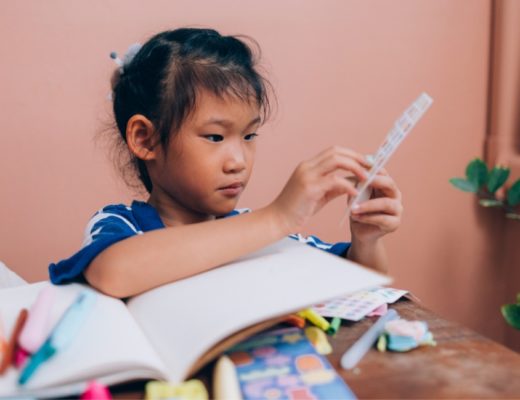
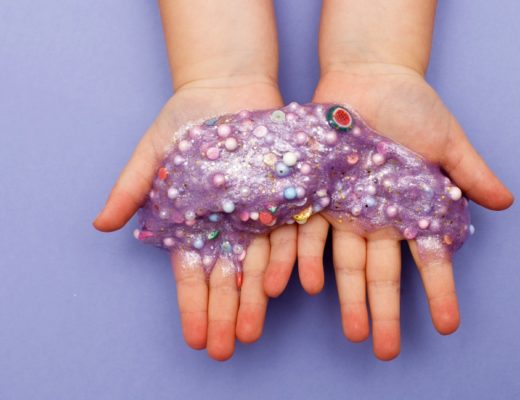
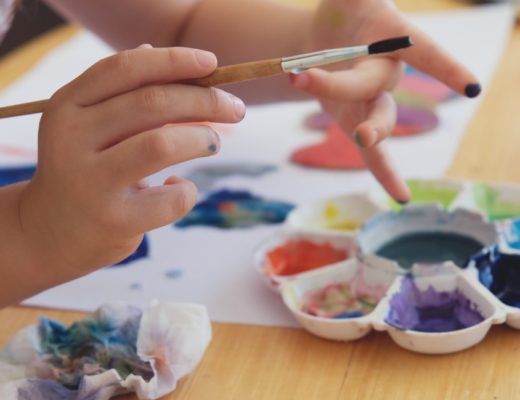
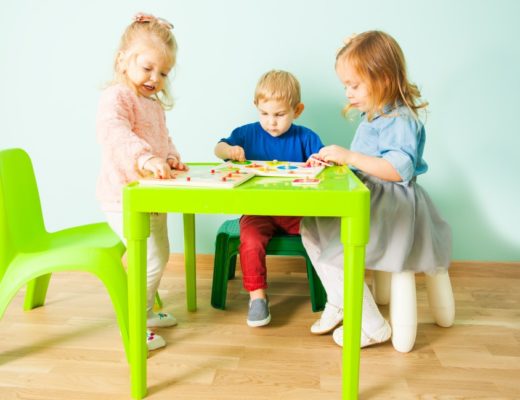
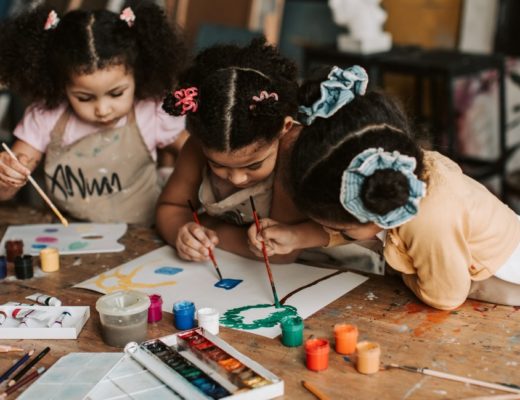
No Comments